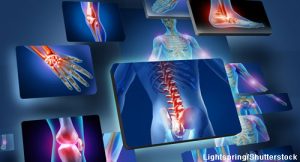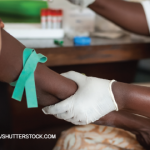 Makras et al. evaluated changes in lumbar spine and femoral neck bone mineral density (BMD) in men with HIV-associated osteoporosis following treatment with denosumab or zoledronate.1 This 12-month, open-label, cohort study was conducted in Greek men living with HIV and taking anti-retroviral therapy who also had low BMD. People living with HIV and people taking anti-retroviral therapy—particularly tenofovir—have a higher risk of developing osteopenia, osteoporosis and fractures, as well as a 1.6 to 3-fold higher risk of fractures compared with the general population.2
Makras et al. evaluated changes in lumbar spine and femoral neck bone mineral density (BMD) in men with HIV-associated osteoporosis following treatment with denosumab or zoledronate.1 This 12-month, open-label, cohort study was conducted in Greek men living with HIV and taking anti-retroviral therapy who also had low BMD. People living with HIV and people taking anti-retroviral therapy—particularly tenofovir—have a higher risk of developing osteopenia, osteoporosis and fractures, as well as a 1.6 to 3-fold higher risk of fractures compared with the general population.2
The study authors note that limited data on the use of intravenous zoledronate and denosumab exist for this patient population. Therefore, they sought to examine the annual changes in BMD of the lumbar spine and femoral neck of these patients while receiving either denosumab or zoledronate.
To be included in the study, patients had to be anti-osteoporotic treatment-naive men living with HIV who had been receiving anti-retroviral therapy for at least one year and who required treatment for osteoporosis according to the current guidelines in Greece.3 Patients were considered eligible for the study if they had at least one of the following:
- A BMD T-score of less than or equal to −2.5 at any skeletal site; and/or
- A FRAX score advocating treatment according to the specific treatment thresholds for patients living with HIV in Greece (described in detail in the study); and/or
- The presence of at least one low energy vertebral fracture and/or hip fracture and/or two non-vertebral fractures.
Patients were recruited from two hospitals in Greece and assigned to receive either a single 5 mg intravenous infusion of zoledronate (n=10) or two 60 mg subcutaneous injections of denosumab given biannually (n=13), based on the treating physician’s choice. BMD was measured at baseline and month 12. Fourteen men living with HIV who had normal BMD were age-matched to serve as controls.
The study’s primary end point was the differences between the two treatment groups in the change in BMD of the lumbar spine from baseline after 12 months. The secondary end point was the differences between the two treatment groups in the change in BMD of the femoral neck after 12 months.
All three groups were assessed for BMD at baseline and at month 12. Baseline demographics between the three groups were similar except for protease inhibitor duration of treatment and 25-hydroxy vitamin D levels. Clinical, demographic and biochemical characteristics were all similar. Participants were mostly in their 50s, with a body mass index around 24, and had been on anti-retroviral therapy for roughly 9–10 years.
The Results
At month 12, the BMD of the lumbar spine increased for both treatment groups. For the zoledronate group, the percent change in BMD was 5.43%±3.60% (P=0.001), and for the denosumab group, it was 5.76%±3.44% (P<0.005). For the control subjects, the percent change in BMD significantly decreased to −2.58%±4.12% (P=0.04).
At month 12, the BMD of the femoral neck also increased in both treatment groups and remained unchanged in the control group. For the patients who were treated with zoledronate, the percent change in BMD was 7.23%±5.46% (P=0.003), and for the patients who were treated with denosumab, the percent change in BMD was 3.01%±2.46% (P<0.005). The control group had no significant or clinical change in BMD (1.22%±2.09%; P=0.06).
The changes in BMD of the lumbar spine between the two treatment groups did not differ, but the changes in BMD of the femoral neck were greater for patients treated with zoledronate (P<0.05) than those treated with denosumab. No new fractures occurred in any of the study patients, no cases of acute phase response were recorded for patients who received zoledronate, and no adverse events were recorded for patients who received denosumab.
In this small study of men living with HIV and taking anti-retroviral therapy and needing osteoporosis treatment, either zoledronate or denosumab was well tolerated and an effective option for obtaining BMD increases for at least one year. Longer-term, randomized, prospective studies, with a longer follow-up period and more patients, are needed to fully assess the long-term effectiveness and safety of these agents in this patient population.
Michele B. Kaufman, PharmD, BCGP, is a freelance medical writer based in New York City and a pharmacist at New York Presbyterian Lower Manhattan Hospital.
References
- Makras P, Petrikkos P, Anastasilakis AD, et al. Denosumab versus zoledronate for the treatment of low bone mineral density in male HIV-infected patients. Bone Rep. 2021 Sep 10;15:101128. eCollection 2021 Dec.
- Chang CJ, Chan YL, Pramukti I, et al. People with HIV infection had lower bone mineral density and increased fracture risk: A meta-analysis. Arch Osteoporos. 2021 Feb 27;16(1):47.
- Makras P, Anastasilakis AD, Antypas G, et al. The 2018 Guidelines for the diagnosis and treatment of osteoporosis in Greece. Arch Osteoporos. 2019 Mar 15;14(1):39.


